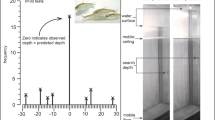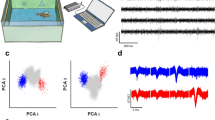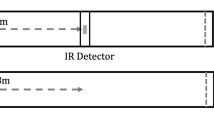Abstract
Distance determination in animals can be achieved by visual or non-visual cues1. Weakly electric fish use active electrolocation for orientation in the dark2. By perceiving self-produced electric signals with epidermal electroreceptors, fish can detect, locate and analyse nearby objects. Distance discrimination, however, was thought to be hardly possible because it was assumed that confusing ambiguity could arise with objects of unknown sizes and materials3,4,5. Here we show that during electrolocation electric fish can measure the distance of most objects accurately, independently of size, shape and material. Measurements of the ‘electric image’ projected onto the skin surface during electrolocation6,7,8 revealed only one parameter combination that was unambiguously related to object distance: the ratio between maximal image slope and maximal image amplitude. However, slope-to-amplitude ratios for spheres were always smaller than those for other objects. As predicted, these objects were erroneously judged by the fish to be further away than all other objects at an identical distance. Our results suggest a novel mechanism for depth perception that can be achieved with a single, stationary two-dimensional array of detectors.
This is a preview of subscription content, access via your institution
Access options
Subscribe to this journal
Receive 51 print issues and online access
$199.00 per year
only $3.90 per issue
Buy this article
- Purchase on Springer Link
- Instant access to full article PDF
Prices may be subject to local taxes which are calculated during checkout




Similar content being viewed by others
References
Collett, T. S. & Harknes, L. I. K. in Analysis of Visual Behaviour (eds Ingle, D. J., Goodale, M. A. & Mansfield, J. W.) 111–175 (MIT Press, 1982).
Lissmann, H. W. & Machin, K. E. The mechanism of object location in Gymnarchus niloticus and similar fish. J. Exp. Biol. 35, 451–486 (1958).
von der Emde, G. in The Physiology of Fishes (ed. Evans, D. H.) 313–343 (CRC, Boca Raton, 1998).
Bastian, J. in Comparative Perception (eds Stebbins, W. C. & Berkeley, M. H.) 35–89 (Wiley, New York, 1989).
Schwarz, S. Diplomarbeit, Institut für Zoologie, Universität Bonn (1997).
Heiligenberg, W. Electrolocation of objects in the electric fish Eigenmannia (Rhamphichthyidae, Gymnotoidei). J. Comp. Physiol. 87, 137–164 (1973).
Caputi, A., Budelli, R., Grant, K. & Bell, C. C. The electric image in weakly electric fish. II Physical images of resistive objects in Gnathonemus petersii. J. Exp. Biol. 201, 2115–2128 (1998).
Rasnow, B. The effects of simple objects on the electric field of Apteronotus. J. Comp. Physiol. A. 178, 397–411 (1996).
Howard, I. P. & Rogers, B. J. Binocular Vision and Stereopsis (Oxford Univ. Press, New York, 1995).
Collett, T. Stereopsis in toads. Nature 267, 349–351 (1977).
Kral, K. & Poteser, M. Motion parallax as a source of distance information in locusts and mantids. J. Insect Behav. 10, 145–163 (1997).
Lehrer, M., Wehner, R. & Srinivasan, M. V. Motion cues provide the bee's visual world with a third dimension. Nature 332, 356–357 (1988).
Schuif, A. & Hawkins, A. D. Acoustic distance discrimination by the cod. Nature 302, 143–144 (1983).
Bleckmann, H. Reception of Hydrodynamic Stimuli in Aquatic and Semiaquatic Animals (Gustav Fischer, Stuttgart, 1994).
Atema, J. Eddy chemotaxis and odor landscapes: exploration of nature with animal sensors. Biol. Bull. 191, 129–138 (1996).
Moller, P., Serrier, J., Belbenoit, P. & Push, S. Notes on the ethology and ecology of the Swashi river mormyrids (Lake Kainji, Nigeria). Behav. Ecol. Sociobiol. 4, 357–368 (1979).
von der Emde, G. The sensing of electric capacitances by weakly electric mormyrid fish: effects of water conductivity. J. Exp. Biol. 181, 157–173 (1993).
Tippler, P. A. Physik (Spektrum Akademischer, Heidelberg, (1994).
von der Emde, G. & Bleckmann, H. Finding food: senses involved in foraging for insect larvae in the electric fish, Gnathonemus petersii. J. Exp. Biol. 201, 969–980 (1998).
Wagner, H. Flow-field variables trigger landing in flies. Nature 297, 147–148 (1982).
Hassan, E. S. in The Mechanosensory Lateral Line. Neurobiology and Evolution (eds Coombs, S., Görner, P. & Münz, H.) 217–228 (Springer, Berlin, 1989).
Bleckmann, H., Tittel, G. & Blübaum-Gronau, E. in The Mechanosensory Lateral Line. Neurobiology and Evolution (eds Coombs, S., Görner, P. & Münz, H.) 501–526 (Springer, Berlin, 1989).
Harkness, L. Chameleons use accommodation cues to judge distance. Nature 267, 346–349 (1977).
Hopkins, C. D. Temporal structures of non-propagated electric communication signals. Brain Behav. Evol. 28, 43–59 (1986).
Suga, N., Butman, J. A., Teng, H., Yan, J. & Olsen, J. F. in Active Hearing (eds Flock, A., Ottoson, D. & Ulfendahl, M.) 13–30 (Pergamon, New York, 1995).
Schnitzler, H.-U., Menne, D. & Hackbarth, H. in Time Resolution in Auditory Systems (ed. Michelsen, A.) 180–204 (Springer, Berlin, 1985).
Dear, S. P., Simmons, J. A. & Fritz, J. Apossible neuronal basis for representation of acoustic scenes in auditory cortex of the big brown bat. Nature 364, 620–623 (1993).
Cialo, S., Gordon, J. & Moller, P. Spectral sensitivity of the weakly discharging electric fish Gnathonemus petersii using its electric organ discharges as the response measure. J. Fish Biol. 50, 1074–1087 (1997).
Zar, J. H. Biostatistical Analysis (Prentice Hall, Englewood Cliffs, 1984).
Hoerl, A. E. J in Chemical Business Handbook (ed. Perry, J. H.) 20–50 (McGraw-Hill, London, 1954).
Acknowledgements
The behavioural experiments and the analysis of the electric images were performed by S.S. during work for his diploma thesis. We thank H. Bleckmann for providing laboratory space and for his continuous support throughout this study; C. C. Bell, H. Bleckmann, J. Mogdans, S. F. Perry, F. Schaeffel and H. Wagner for critically reading the manuscript and helpful discussions; C. Gutzen for help with the figures; and W. Alt for statistical advice. G.v.d.E. is a recipient of a Heisenberg stipend of the DFG. This work was financed partly by a research grant from the EC to K.G. by the Franco-German international exchange programme PROCOPE, by the Franco-Uruguayan exchange programme ECOS and by a doctoral fellowship to L.G. from the French Ministry of Foreign Affairs.
Author information
Authors and Affiliations
Corresponding author
Rights and permissions
About this article
Cite this article
von der Emde, G., Schwarz, S., Gomez, L. et al. Electric fish measure distance in the dark. Nature 395, 890–894 (1998). https://doi.org/10.1038/27655
Received:
Accepted:
Issue Date:
DOI: https://doi.org/10.1038/27655
This article is cited by
-
Biologically Inspired Catheter for Endovascular Sensing and Navigation
Scientific Reports (2020)
-
Representation of object’s shape by multiple electric images in electrolocation
Biological Cybernetics (2019)
-
Jamming Avoidance Response Inspired by Wave-type Weakly Electric Fish
Journal of Bionic Engineering (2018)
-
Electrosensory capture during multisensory discrimination of nearby objects in the weakly electric fish Gnathonemus petersii
Scientific Reports (2017)
-
A novel evolutionary technique based on electrolocation principle of elephant nose fish and shark: fish electrolocation optimization
Soft Computing (2017)
Comments
By submitting a comment you agree to abide by our Terms and Community Guidelines. If you find something abusive or that does not comply with our terms or guidelines please flag it as inappropriate.



